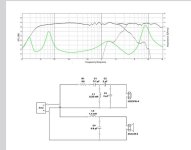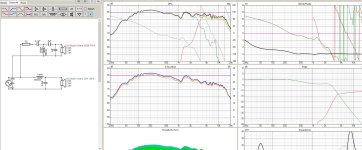Hi Guys
I am building my firs set of desktop speakers and am currently designing the crossover.
I am trying to cross the Dayton Audio DSA135-8 5" & ND25FW-4 1".
From what I have learned the right place to cross these, is around 3000Hz.
This is the schematic I came up with after following the basic Guide by AllenB and tweaking it a bit.
What do you guys think? Is this a usable crossover?
Also I might want to change the tweeter for the Peerless by Tymphany BC25SC08-04 for aesthetic reasons.
I have attached the spec sheets for reference below.
Would love some feedback!
Thanks
Sam

Response Simulation Dayton Tweeter

Peerless Tweeter


I am building my firs set of desktop speakers and am currently designing the crossover.
I am trying to cross the Dayton Audio DSA135-8 5" & ND25FW-4 1".
From what I have learned the right place to cross these, is around 3000Hz.
This is the schematic I came up with after following the basic Guide by AllenB and tweaking it a bit.
What do you guys think? Is this a usable crossover?
Also I might want to change the tweeter for the Peerless by Tymphany BC25SC08-04 for aesthetic reasons.
I have attached the spec sheets for reference below.
Would love some feedback!
Thanks
Sam
Response Simulation Dayton Tweeter
Peerless Tweeter
Attachments
Last edited:
You are correct, this is my first crossover so I was trying to keep it simple.
How important is it really? I am going to listen to them mainly on-axis.
How important is it really? I am going to listen to them mainly on-axis.
For proper tonal balance it is crucial: otherwise you will end up with a thin, shrill sounding system if used free-standing. The desk may offer some compensation, but i.m.o. that is still sub optimal. Strictly speaking you should both make a near field measurement of your woofer plus a desktop placed measurement and combine both (a technique known as "merging"), before you sim the x/o. That being said I do not know any design particulars of desktop speakers. There is a Jeff Bagby paper. Google for:
How to Achieve Accurate In-Room Quasi-Anechoic Free-Field Measurements
You can't omit the baffle step effect, because unless you are building an infinite wall speaker (e.g. an in-wall speaker), the baffle step effect will change the natural FR of the drivers. The FR you are using are on an infinite baffle. If you don't compensate the baffle step effect, the resulting speaker will be bass-anemic, with a forwarding midrange. Note that you probably don't need to fully compensate the effect, but you should compensate at least 3-4 dB.You are correct, this is my first crossover so I was trying to keep it simple.
How important is it really? I am going to listen to them mainly on-axis.
VituixCAD has a tool to manipulate FR in order to calculate the baffle step effect imposed by the baffle you are using.
As for the crossover, there are some things that you need to address.
- use only standard values (there is no 7.94 uF cap or the likes)
- remove the resistor in parallel to the woofer
- values of the LP filter (first simulation) seems far off
Ralf
Have a look at this project with dsa135, for measurements and x-over inspiration:
https://ampslab-spk.com/2019/08/04/hummingbird-2/
https://ampslab-spk.com/2019/08/04/hummingbird-2/
Last edited:
Your drivers are the same as the Parts Express C-Note speaker. The xo is publicly available, why not just us it? (PDF of xo schematic is on the PE product page under Manuals & Resources.)
Underpowered Woofer (Bass) ?
Hello again.
I went ahead and ordered the parts. I soldered together the crossover and gave it a quick test. However in my opinion the woofer seems way underpowered in comparison to the tweeter and generally lacks umpf. I was expecting more after seeing this video:
https://www.youtube.com/watch?v=Mqp2R7Qvavk&ab_channel=Doublsmm
This is the crossover schematic I came up with:


Hello again.
I went ahead and ordered the parts. I soldered together the crossover and gave it a quick test. However in my opinion the woofer seems way underpowered in comparison to the tweeter and generally lacks umpf. I was expecting more after seeing this video:
https://www.youtube.com/watch?v=Mqp2R7Qvavk&ab_channel=Doublsmm
This is the crossover schematic I came up with:
Hello everyone! I hope you don't mind me reviving this older discussion, but I have the same driver combination in a Harman LS3/5a box and I'm facing a similar crossover question. I took your suggestion to check out the C-Note Kit from Parts Express since it features the same drivers.Your drivers are the same as the Parts Express C-Note speaker. The xo is publicly available, why not just us it? (PDF of xo schematic is on the PE product page under Manuals & Resources.)
I imported the schematic into Vituix, using the FRD and ZMA files for each driver, which I found on the Parts Express page for the corresponding Dayton Drivers. I'm a bit puzzled because the curve I generated in Vituix differs from the one provided in the C-Note Speaker measurements. I've attached both curves for comparison. Can anyone shed some light on why this discrepancy exists? As you see, in vituix I don't get a flat response.
Thank you
Attachments
I suspect the issue is that the C-Note measurements were taken with the drivers in the box, whereas PE's measurements - while generally regarded as accurate - are measured on a 'infinite baffle'.
To illustrate the point, here are measurements of a well known DIY speaker: the top is my modelling in Xsim (another widely used XO simulator) using just the makers' data, the bottom is how it measures with the drivers and actual crossover in the cabinet, taken from the designers' website:


Geoff
To illustrate the point, here are measurements of a well known DIY speaker: the top is my modelling in Xsim (another widely used XO simulator) using just the makers' data, the bottom is how it measures with the drivers and actual crossover in the cabinet, taken from the designers' website:
Geoff
Last edited:
Hello Geoff, thank you so much, that makes sense. I have to figure out a way in vituix, to simulate the measures of the LS3/5A BBC Box. I am looking for a sealed design. I am using the JBL 305 for many years for mixing but also found pleasure mixing on a 2nd pair of sealed monitors. While getting less bass, I hear better transients and tighter bass response.
What I am still puzzled about: The C-Note Box has a bit more volume and is not sealed, it has a bassreflex. So I expect a different behaving in the lows. Still not understanding, why the crossover response is behaving so differently. That 4 db bump around 1k is strange
The size of the box and port tuning determines the low end output. This is about 100hz and below and does not effect anything near the crossover point.
If you're box/baffle is close to the same width as the C-Notes, then arrange the drivers the same distance from the top and each other and the C-Notes crossover should be okay. If you're box is MUCH wider, then it may not work well.
If you're box/baffle is close to the same width as the C-Notes, then arrange the drivers the same distance from the top and each other and the C-Notes crossover should be okay. If you're box is MUCH wider, then it may not work well.
- Home
- Loudspeakers
- Multi-Way
- 2-Way Crossover DSA135-8 5" & ND25FW-4 1" Soft Dome

